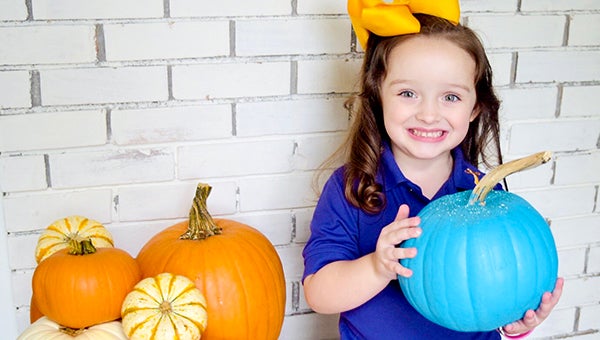Halloween can be scary for children with food allergies
Published 12:29 pm Tuesday, October 22, 2019

- Elvie Grace Bradley, 3, shows off her teal pumpkin. In 2012, the Teal Pumpkin Project began with the goal of raising awareness of food allergies and promotes inclusion of all trick-or-treaters. If a teal pumpkin is placed in front of a home, this signals non-food treats are available. (Terri Cowart Frazier/The Vicksburg Post)
Trick-or-treating is a highlight for children on Halloween.
Running up to a house, ringing the doorbell, saying “trick-or-treat” and then walking away with candy can’t be beaten.
That is unless you have a food allergy.
“Halloween makes me a nervous wreck,” Lindsey Bradley said.
Bradley’s 3-year-old-daughter, Elvie Grace, lives with an allergy to peanuts and all tree nuts.
“She can’t even have food that is manufactured in a place where food with nuts are made,” Bradley said.
But thanks to the Teal Pumpkin Project, which was inspired by a local awareness activity run by the Food Allergy Community of East Tennessee and in partnership with the Food Allergy Research & Education (FARE) organization in 2012, children like Elbie can also enjoy trick-or-treating.
“The Teal Pumpkin Project is an initiative that focuses on the inclusion of children with dietary restrictions, enabling them to trick-or-treat safely,” Dr. Lisa Fairchild said.
Fairchild, who is a physician in the Merit Health Group pediatric clinic, said placing a teal pumpkin outside your home indicates the house is an allergy-friendly home providing non-food treats.
“I love this,” Bradley said of the Teal Pumpkin Project. “It is so nice to pull up to a house at Halloween and they actually have something besides candy.”
Fairchild said the most common food allergy in children is milk, followed by eggs. And like Elbie, Fairchild said, peanuts and tree nuts are also common food allergies.
Bradley said that just because nuts might not be visible in a particular candy does not mean the candy is safe for those with allergies. “Nuts are in just about everything,” she said.
“The other day, I looked on the back of a cooking spray, and it had walnuts in it,” she said. “I had never thought about a cooking spray having walnuts in it.”
Fairchild said, “Signs of an allergic reaction include hives all over the body, swelling of the lips and tongue, cough, wheezing, difficulty breathing, vomiting and dizziness, which is a severe life-threatening allergic reaction called anaphylaxis.”
Bradley said her daughter is aware of her allergies and tells people she cannot have nuts or peanut butter.
She also wears a bracelet and has an epi-pen.
Bradley said she does not want her daughter to grow up being excluded, so having another option at Halloween is important.
“A lot of people don’t know how it (food allergies) affects you until it happens to your child,” Bradley said.
For those who want to be part of the Teal Pumpkin Project, FARE’s suggests treats like glow sticks, pencils, markers, bubbles, bouncy balls, playing cards, bookmarks and stickers.
And if one chooses to offer both candy and non-food items for trick-or-treaters make sure they are made available in a separate bowl.
In a study conducted by researchers from Ann & Robert Lurie Children’s Hospital of Chicago, 5.6 million children suffer from food allergies. Of these children, the study also revealed one in five needed treatment in the emergency room in 2018 with a life-threatening reaction to food.
For instructions on how to make a teal pumpkin, visit www.foodallergy.org/about-fare/blog/craft-your-way-to-the-perfect-teal-pumpkin-diy-tutorial.
In addition to food safety for children with allergies, Halloween safety for all those on and off the road should be observed.
Below is a list of safety suggestions from the American Academy of Pediatrics include:
Costume safety
• All costumes, wigs and accessories should be fire-resistant
• Avoid masks, which can obstruct vision
• If children are allowed out after dark, fasten reflective tape to their costumes and bags, or give them glow sticks
• When buying Halloween makeup, make sure it is nontoxic and always test it in a small area first
• Remove all makeup before children go to bed to prevent skin and eye irritation
Out on the Road
• A responsible adult should accompany young children on the neighborhood rounds
• If older children are going alone, plan and review an acceptable route
• Agree on a specific time children should return home
• Teach children never to enter a stranger’s home or car
• Instruct children to travel only in familiar, well-lit areas and stick with their friends
• Tell children not to eat any treats until they return home
• Children and adults are reminded to put electronic devices down, keep heads up and walk, don’t run, across the street






